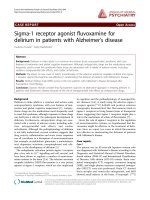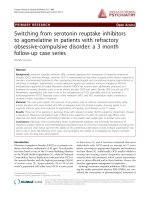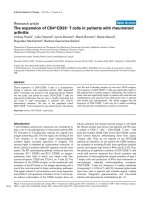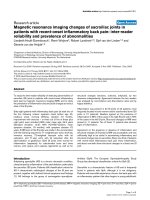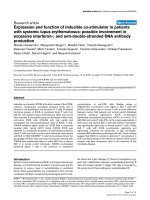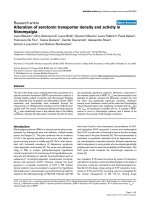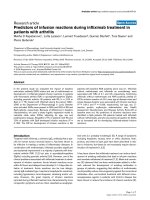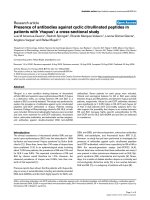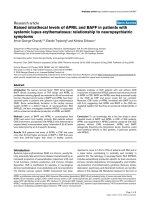Báo cáo y học: "Switching from serotonin reuptake inhibitors to agomelatine in patients with refractory obsessive-compulsive disorder: a 3 month follow-up case series" doc
Bạn đang xem bản rút gọn của tài liệu. Xem và tải ngay bản đầy đủ của tài liệu tại đây (237.16 KB, 8 trang )
PRIMARY RESEARCH Open Access
Switching from serotonin reuptake inhibitors
to agomelatine in patients with refractory
obsessive-compulsive disorder: a 3 month
follow-up case series
Michele Fornaro
Abstract
Background: Serotonin reuptake inhibitors (SRIs) currently represent the cornerstone of obsessive-compulsive
disorder (O CD) pharmacotherapy. However, OCD is characterized by high rates of partial and/or absent response to
standard, recommended treatments, often prompting pharmacological and non-pharmacological augmentation or
switching of strategies. Agomelatine, a novel melatonin agonist and selective serotonin antagonist (MASSA)
antidepressant approved for major depressive disorder (MDD) has recently been additionally proposed as a
treatment for anxiety disorders such as social anxiety disorder (SAD) and panic disorder (PD), but not yet OCD.
Nonetheless, agomelatine may have a role in the management of OCD, essentially due to its anxiolytic 5-
hydroxytryptamine (HT)2C blockade action, while melatonin (MT)1 and MT2 modulation might contribute to
circadian rhythm restoration if impaired.
Methods: This case series reports the outcome of six patients with or witho ut comorbid mood and/or other
anxiety disorders who were treated with SRIs at adequate doses for at least 8 weeks, showing partial or no
response. Patients were then switched to agomelatine 50 mg/day, and followed up for 12 weeks.
Results: Three out of six patients, in particular those with relevant circadian rhyt hm subjective impairment, showed
a Yale-Brown Obsessive Compulsive Scale (Y-BOCS) score reduction of ≥35%. No relevant side effects were
observed, but initial, transient, self-remitting dizziness in one patient and weight gain in another were seen.
Conclusions: Although clinical confounding factors (subthreshold bipolarity and eventually the presence of
impaired circadian rhythms) and methodological boundaries (lack of control and neurophysiological recording, tiny
sample size and short follow-up) limit the validity of this preliminary observation, it does indicate agomelatine may
have a role in some SRI-refractory OCD cases, thus promptin g the validity of investigation by further controlled
studies, even for drug-naïve OCD patients.
Introduction
Obsessive-com pulsive disorder (OCD) is a common con-
dition that affects individuals of all ages. This disorder
has b een listed as one of the 10 most disabling illnesses
by the World Health Organization [1], while the National
Comorbidity Survey Replication indicated that OCD is
the anxiety disorder with the highest percentage (50.6%)
of serious cases [2]. Approximately 2% to 3% of the
world’s population will suffer from OCD at some point
in their lives [3], and it has been estimated that most
individuals with OCD spend an average of 17 years
before receiving an appropriate diagnosis and treatment
for their illness [4]. Additionally, OCD usually exhibits a
waxing and waning course, frequently increasing in
severity when left untreated, which causes unnecessary
pain to those afflicted and to their families. Hence, the
need for appropriate management is imperative.
Although serotonin reuptake inhibitors (SRIs), includ-
ing the widely prescribed selective SRIs (SSRIs), are con-
sidered the cornerstone of pharmacological treatment of
Correspondence:
University of Genova, Department of Psychiatry, Genoa, Italy
Fornaro Annals of General Psychiatry 2011, 10:5
/>© 2011 Fornaro; licensee BioMed Central L td. This is an Open Access article distributed under the terms of the Creative Commons
Attribution License (http://creative commons.org/licenses/by/2.0 ), whi ch permits unrestricted use, distribution, and reproduction in
any medium, provided t he original work is properly ci ted.
OCD [5], at least 40% of cases do not respond satisfac-
torily to these medications [6]. Augmentation strategies
with antipsychotic medications, psychotherapies such as
cognitive behavioral therapy (CBT) and others [7], as
well as switching to newer classes of drugs such as the
selective serotonin norepinephrine reuptake inhibitors
(SNRIs) [8] have all been considered. Indeed, OCD
management remains a debated issue essentially due to
a still not fully understood etiopathology and to a num-
ber of eventually concomitant clinical features, mainly
referabletobipolarity[9],whichmayaccountforsome
of the treatment-refractory cases.
Within the past few years, greater attention has been
paid toward the neurobiological factors underpinning
OCD, including the investigation of circadian rhythms
[10] and neurosteroid [11] imbalance. Among other fac-
tors, a delayed slow wave sleep (SWS) phase [10] as well
increased nocturnal secretion of adrenocorticotropic
hormone (ACTH) and cortisol, a melatonin-related [12]
‘stress hormone’ [13], have been documented in the course
of some OCD cases, although the investigation of the cir-
cadian pattern by proxy measurement (axillary tempera-
ture) essentially showed the absence of a relationship
between OCD and melatonin [14], so it remains unclear if
and how circadian rhythm impairment might subjectively
or objectively impact on OCD burden and its perception.
Recently, the availability of agomelatine, a novel anti-
depressant acting as a melatonin agonist and selective
serotoni n antag onist (MAS SA; acting against melatonin
1 (MT1) and MT2, and 5-hydroxytryptamine (HT)2C,
respectively) [15] led to the exploration of its potential
role even for anxiety disorders [16,17], suggesting its
possible use for OCD.
This paper reports a case series of six patients with
SRI-refractory OCD diagnosed with the Structured Clin-
ical Interview for the Diagnostic and Statistical Manual
of Mental Disorders, fourth edition (DSM-IV) Axis-I
(SCID-I) [18] who were switched from SRIs to agomela-
tineandfollowed-upforatleast3months.Thisisthe
first report of its kind in the literature to date.
Patients were considered refractory to an adequate
treatment (administration of an effective daily dose of
SRI, that is, fluoxetine 40-60 mg/day or clomipramine
225-300 mg/day, for a minimum of 8 weeks) [19] on the
basis of a Yale-Brown Obsessive Compulsive Scale (Y-
BOCS) score >18 [20]. All patients started agomelatine
treatment at 50 mg/day (the c urrent approved dose
range for treating major depressive disorder (MDD) is
25-50 mg/day), which lasted for a minimum of 12 weeks
with mo nthly evaluations of obsessive-compulsive (OC)
symptoms through Y-BOCS administration. Administra-
tion of the Hamilton Scale for Depression (HAM-D)
[21] and Hamilton Scale for Anxiety (HAM-A) [ 22] was
performed at baseline and at week 12. The Biological
Rhythms Interview of Assessment in Neuropsychiatry
(BRIAN), a 18-item screening tool designed to help clin-
icians better assess their patients and researchers
improve the evaluation of the impact of novel therapies
targeting biological rhythm path ways [23], was adminis-
tered at baseline and at week 12 (end point). Remark-
ably, considering the clinical setting of this preliminary
investigation, the evaluation of circadian rhythm func-
tioning was subjective and did not inclu de any objective
neurophysiological monitoring such as polysomnography
despite the acknowledgement of reduction of sleep onset
rapid-eye movement periods (SOREMPs) as rapid eye
movement (REM) latencies in the course of OCD [24].
Additionally, with the aim to detect further potential
clinical fa ctors still accounting for treatment refractori-
ness, a systematic assessment of temperament and soft
bipolar spectrum signs, as well as evaluation of other
clinical features potentiall y linked to treatment refrac-
toriness (Table 1), including ‘ poor insight’ OCD (PI-
OCD), was performed on all patients at week 12 using
the lifetime Temperament Evaluation of the Memphis,
Pisa, Paris, and San Diego lifetime Autoquestionnaire
(TEMPS-A) [25] and t he Brown Assessment of Beliefs
Scale (BABS) [26] which was also administered at base-
line. The B ABS is a seven-item questionnaire rating a
number of dimensions that underlie delusional and non-
delusional beliefs, developed to assess the degree of
insight of illness, a clinical feature generally directly
related to the propensity t oward SRI response [27,28].
The TEMPS-A is a comprehensive questionnaire specifi-
cally developed to assess temperamental (for example,
cyclothymic) or personality (for example, cluster A)
traits that may account for lack of response to standard
medications or even for worsening of the clinical picture
on antidepressants (including i ncreased risk for suicidal
attempts) [29-31]. Finally, all the patients appeared stea-
dily co mpliant toward medications and underwent
weight monitoring as well liver function tests (LFTs) at
baseline and at week 12 (all negative) in accordance
with the recent guidance proposed by the European
Agency of Medicines (EMEA) [32].
At the end of the study, three out of six patients, in
particular thos e reporting higher subj ective sleep dis tur-
bancesatbaselinebutnotattheendpoint,showeda
clinically significant OC improvement (Y-BOCS reduce
by ≥35%). Interestingly, patients largely unchanged within
the 3 month trial with 50 mg/day agomelatine (n = 3) did
not report any relevant circadian rhythm impairment at
baseline or end point, but were more suggestive for ‘soft
bipolar’ features according to the TEMPS-A evaluation
(two out of three had a cyclothymic temperament) and/
or had poor insight features.
Concerning the side-effect profile, agomelatine
50 mg/day was a generally well tolerated therapy,
Fornaro Annals of General Psychiatry 2011, 10:5
/>Page 2 of 8
although one patient exhibited weigh gain and another
experienced, transient (spontaneously remitting) dizzi-
ness despite a prudent downtitration from the previous
SRI medication.
Case series
The first patient was a single 35-year-old worker, who first
started to develop OC symptoms at the age of 23. A year
after being left by his girlfriend, he showed a sudden wor-
sening of the disorder. (Clinical and demographical char-
acteristics of all patients are summarized in Table 2 and
Figure 1.) He was obsessively worried about the chance his
ex-fiancé would get engaged to someone else and con-
cerned about his subsequent inability to work. Compulsive
shopping for audio CDs and sporadic cocaine use were
then associated with a progressive social withdrawal (ful-
filling DSM-IV criteria for social anxiety disorder (SAD))
and continuous ruminative/dubitative thoughts. The
patient had already reported a history of partial/no
response to SRIs and resistant MDD prior receiving
60 mg/da y of fluoxetine for 6 months wit hout exhi biti ng
any further substantial benefit (Y-BOCS score = 35). After
a 3 week wash-out period from fluoxetine, depressive and
anxious symptoms were assessed and quantified with a
HAM-D21 of 27 (severe), HAM-A of 44 (very severe) and
BRIAN scale highlighting almost steady ‘social’ and ‘predo-
minant rhyt hm’ impairments but not relevant subjective
disruption of sleep rhythm within the whole agomelatine
trial. According to a BABS score of 12 and a score of 2 for
the ‘conviction’ item in particular, the patient maintained
a substantial insight of illness [33]. Agomelatine was then
started at 50 mg/day but all the monthly assessment Y-
BOCS measurements were largely stable, with a week
12 total score of 36 (slight increase, largely not modified)
and a week 12 BABS score of 11. Weight gain (+4 kg
in 3 months; baseline BMI = 32; end point BMI = 34: sec-
ond degree obesity) was the only relevant side effect. Inter-
estingly, upon suggestion of a plausible cyclothymic
temperament acco rding to the clinical impression and
administration of TEMPS-A at week 12, the patient was
then switched to lithium carbonate 900 mg/day (lithium
serum levels = 0.74 mEq/L) plus queti apine 300 mg/day,
showing a slight clinical reduction of OC symptom load
just after a further month of antidepressant-free therapy
and a remarkable, unexpected reduction of body weight
by 3 kg.
The second patient was a 44-year-old trader who
received his first diagnoses of OCD, impulse control and
substance abuse disorders at the age of 36. His OC
symptoms were essentially represented by repetitive
belching compulsions and fear about losing self-control
in the presence of other people, especially his customers,
with consequent impact on his ability to work. The typi-
cal OCD egodystonic characteristic was almost lost over
the years, leading to trials of multiple SRI prescriptions
(including clomipramine 300 mg/day and other tricyclic
antidepressants (TCAs)) augmented with the typical
antipsychotic pimozide (4 mg/day) for the ‘poor insight’
feature(confirmedbyabaselineBABStotalscoreof
28 with ‘conviction’ item score = 4, the maximum possi-
ble score, inversely related to insight of illness). His last
SRI prescription was sertral ine 200 mg/day correspond -
ing to a Y-BOCS score of 21 (HAM-D21 = 15; HAM-A =
16; BRIAN ‘seldom’ = acceptable in most of the domai ns
but with severe, stable subjectiv e initial insomnia already
unresponsive to benzodiazepines (BDZs) and antihista-
mine d rugs) prior to a 2 we ek wash-out period and sub-
sequent therapy with agomelatine 50 mg/day. Mont hly
Table 1 Examples of clinical factors potentially linked to obsessive-compulsive disorder (OCD) treatment-refractory
responses
Eventual OCD clinical features contributing to OCD refractory
response toward SRI antidepressants
Assessment Sample references by first author and year
Poor-insight feature, global severity of OCD Clinical interview/BABS/Y-
BOCS
Ravi Kishore 2004 [28]; Goodman 1989 [20]
Age at onset, familial history, duration of untreated illness and other
sociodemographic features
Clinical interview/SCID-I
demographics
First 1997 [18]; Fornaro 2009 [7]
Axis-I comorbidities (for example, MDD/other anxiety disorders) Clinical interview/SCID-I/
HAM-D/HAM-A
First 1997 [18]; Fornaro 2009 [7]; Hamilton 1960
[21]; Hamilton 1959 [22]
Temperamental/personality traits Clinical interview/TEMPS-
A
Hantouche 2003 [29]; Akiskal 2005 [25]
Medical comorbidities, including those affecting the cognitive status Clinical interview/specific
assessment
Fornaro 2009 [7]
Impaired circadian rhythms? BRIAN Giglio 2009
a
[23]
a
Further clinical features may predict treatment-refrac tory response to SRIs among OCD patients; while the chance of response tends to reduce with increase of
total comorbidities and higher severity of illness, the eventual impact of some features as impairment of circadian rhythm still needs further assessment.
BABS = Brown Assessment of Beliefs Scale; BRIAN = Biological Rhythms Interview of Assessment in Neuropsychiatry; HAM-A/D = Hamilton Scale for Anxiety/
Depression; MDD = major depressive disorder; SCID-I = Structured Clinical Interview for the Diagnostic and Statistical Manual of Mental Disorders, fourth edition
(DSM-IV) Axis-I; SRI = serotonin reuptake inhibitor; TEMPS-A = Temperament Evaluation of the Memphis, Pisa, Paris, and San Diego lifetime Autoquestionnaire;
Y-BOCS = Yale-Brown Obsessive Compulsive Scale.
Fornaro Annals of General Psychiatry 2011, 10:5
/>Page 3 of 8
scheduled Y-BOCS score measurements indicated a pro-
gressive and fast, substantial reduction (Y-BOCS at week
4=16;week8=11;week12=9;week12BABSof10
and subjective improve ment sleep quality according to
the BRIAN) without relevant side effects. Actual pharma-
cological regimen, including 4 mg/day pimozide and the
anticholinergic drug biperidone 4 mg/day augmentation
(added to prevent extrapyramidal symptoms), was con-
firmedinthepresenceofaTEMPS-A-demonstrated
anxious temperament.
The third patient was a married, 66-year-old retired
woman whose OC symptoms consisted of religious
obsessions, continuous rituals rega rding touching holy
pictures of saints in her pocket and continuative fear of
cursing against God. Both cognitive status and insight of
illness (as measured by a BABS total score of 11) were
maintained without any significant personal or familial
medical or psychiatric anamnesis. The patient showed
her first symptoms at the age of 57 when she experi-
enced the loss of her only daughter, a nun. When the
patient retired from her occupation (teacher) at the age
of 60 she progressively experienced a worsening of her
symptomatology, which became more time consuming
until she finally sought medical care. She underwent dif-
ferent ‘ adequate’ SRI trials (both with TCAs and SSRIs)
prior to being treated with fluoxetine 60 mg/day. Before
being switched to agomelatine 50 mg/day (after the
3 week wash-out period for fluoxetine), her symptoma-
tology was quantified as Y-BOCS = 22, HAM-D21 = 23
and HAM-A = 25, while the BRIAN scale showed a pre-
dominant ‘activity’ pattern impairment (’sometimes’)but
not a remarkable impairment of sleep pattern. None of
the subsequent observations showed modification in the
reference scores apart from HAM-A, which was reduced
Table 2 Clinical and demographic characteristics of SRI-refractory OCD patients treated with agomelatine 50 mg/day
for a minimum of 3 months
Patient 1 Patient 2 Patient 3 Patient 4 Patient 5 Patient 6
Age 35 44 66 53 25 33
Age at onset 23 36 57 20 15 24
Gender M M F F M F
DSM-IV Axis-I
comorbidities
Resistant MDD,
social anxiety
disorder
Impulse-control
disorder,
substance abuse
disorder
None Bulimia nervosa, panic
disorder
None Panic disorder
First-degree relatives
family history
Bipolar disorder
II (brother)
ADHD (son) None None None None
Side effects Weight gain
(BMI 32 to 34
within 3
months)
None None None None Dizziness (initial,
spontaneously
remitting)
Last failed SRI trial Fluoxetine 60
mg/day
Sertraline 200 mg/
day
Fluoxetine
60 mg/day
Amitriptyline 300 mg/day Fluvoxamine 250
mg/day
Duloxetine 120 mg/
day + CBT
Main clinical
features/OC
symptoms
Doubt/
compulsive
shopping
Belching
compulsion
Religious/
touching
Hoarding/insertion of thought
and intrusive images with
sexual contents/checking
Checking/repeating Fear of losing
control toward food
(in absence of BED)
Y-BOCS total score
(baseline to week
12)
Not modified Remission: 21 to 9 Not
modified
Not modified Remission: 32 to 11 Remission: 22 to 8
Actual, subjective
circadian rhythms
impairment (BRIAN)
Any relevant
disruptions
Reported stable
insomnia
Any
relevant
disruptions
Any relevant disruptions Reported daily
hypersomnia and
nocturnal
awakening
Any relevant
disruptions
Lifetime bipolar
spectrum signs
(TEMPS-A at week
12)
Cyclothymic
temperament
Anxious
temperament
Any
specific
Cyclothymic temperament Any specific Any specific (but
presence of PD)
Poor insight feature
(BABS, baseline-
week 12)
No (stable) Yes®No No (stable) No (stable) No (stable) No (stable)
Patient 6 received CBT within the 3 month trial with agomelatine; psychotherapy had already been established at least 6 months earlier.
ADHD = attention deficit hyperactivity disorder; BABS = Brown Assessment of Beliefs Scale; BED = Binge Eating Disorder; BMI = body mass index; BRIAN =
Biological Rhythms Interview of Assessment in Neuropsychiatry; CBT = cognitive behavioral therapy; DSM-IV = Diagnostic and Statistical Manual of Mental
Disorders, fourth edition; MDD = major depressive disorder; SRI = serotonin reuptake inhibitor; OC = obsessive compulsive; PD, panic disorder; TEMPS-A =
Temperament Evaluation of the Memphis, Pisa, Paris, and San Diego lifetime Autoquestionnaire; Y-BOCS = Yale-Brown Obsessive Compulsive Scale.
Fornaro Annals of General Psychiatry 2011, 10:5
/>Page 4 of 8
by 2 points (HAM-A = 23) after the 12 week follow-up
assessment; her week 12 BABS score was 10 and
Y-BOCS = 22 at baseline. Analogously, administration
of TEMPS-A did not show any relevant temperamental
feature.
The fourth patient was a 53-year-old painter who
developed her first OC symptoms at the age of 20. The
patient also reported a history of bulimia nervosa (BN)
diagnosed at the age of 24 (apparently spontaneously
recovered after 8 years) and a lifetime history of panic
disorder (PD) diagnosed by the age of 21. Her OC symp-
toms, mainly consist ing of hoarding, insertion of thou ght
(sexual images when painting fruits or o ther objects
which shape could resemble her the male genitals) and
checking rituals were very disabling and she said they
might have eventually lead her to ‘commit suicide to stop
her sufferance. The patient had a firm insight of illness
(baseline BABS total score = 9). The patient was treated
with CBT from the age of 29, leading to repetitive failure
and a final cessation of any psychotherapeutic support.
She started her pharmacotherapy with amitriptyline
300mg/dayattheageof44exhibitingatransient
response. Although reporting an episodic course of
anxious illness (instead of a chronic waxing course) and
BN and PD predictive factors, she had no personal or
familial history for bipolar disorders (BD) but had a
TEMPS-A result suggestive for cyclothymic tempera-
ment, despite absence of manic switch history even at
considerable TCA doses without mood stabilizers. Before
being switched to agomelatine 50 mg/day (after 2 week
wash-out period for amitriptyline), her symptomatology
was quantified by Y-BOCS = 27, HAM-D21 = 23 and
HAM-A = 17 scores, while the BRIAN scale result
showed a predominant ‘social’ pattern impairment
(’ often’ =mostofthetime)butnotsleepcoredisrup-
tions. Over the whole 3 month follow-up, agomelatine
was not associated with any side effects, including (hypo)
mania, but was not related to any clinical improvement
either (at week 12, Y-BOCS = 26 and BABS = 9).
The patient decided to return to her psychotherapist,
disregarding the advice of waiting longer for a potential
onset of action of the pharmacological treatment,
switching to an atypical antipsychotic, or th e suggestion
of a combined approach.
The fifth patient was a 25-year-old student who exper i-
enced his first OC symptoms at the age of 15, predomi-
nantly consisting in checking behavior (door locks, gas
knobs on the cooker and so on) and repeating, schizoty-
pal-like (baseline BABS = 13) rituals (for example, men-
tally counting pairs of numbers in a 10 min perio d every
3 h). Considering the age of the subject and the early
onset of the symptoms, OCD appeared severe, as con-
firmed by a Y-BOCS total score of 32 even after an
8 month trial with fluvoxamine 250 mg/day, with rele-
vant social withdrawal and (law) college co urse abandon-
ment associated with daily hypersomnia an d nocturnal
awakening. No familial or personal comorbidities were
shown. At that point, his HAM-D21 total score was 25,
HAM-A = 39 and BRIAN results showed almost constant
‘chronotype’ and ‘sleep’ disruptions. After a 2 week SSRI
wash-out period, the patient started a 50 mg/day agome-
latine trial, showing a progressive, considerable remission
(Y-BOCSatweek4=19,Y-BOCSatweek8=13,
Y-BOCS at week 12 = 11 and week 12 BABS = 8). Almost
all the OC symptoms appeared to be in remission and his
circadian rhythms recovered, suggesting continuation of
the same therapy in the absence of any relevant TEMPS-
A temperamental cluster. Finally, no side effects were
reported during the treatment.
The sixth and final patient was 33-year-old waitress
who developed her first OC symptoms at the age of 24.
Her obsessions were mainly related to fear of lack of con-
trol toward food. Curiously, she had no personal or
familial history for any eating diso rder (ED), including
binge eating disorder (BED) or night eating, or any dys-
morphophobic bodily perceptions, but had a personal
historyofPDwithepisodicattackssincetheageof18.
She had a history of repetitive failure on antidepressant
trials, with the last one being the SNRI duloxetine
120mg/dayandtheBDZclonazepam4mg/dayfor
3monthsplusCBTfor6months.Atbaseline,her
Y-BOCS total score was 22 and BABS = 9 with HAM-
D21 = 22 and HAM-A = 35. BRIAN administration did
Figure 1 Yale-Brown Obsessive Compulsive Scale (Y-BOCS)
trends within 3 months of administration of agomelatine 50
mg/day in serotonin reuptake inhibitor (SRI)-refractory
obsessive-compulsive disorders (OCDs). When remission
occurred, it was substantial. In contrast, those refractory to
agomelatine in the trial were largely unchanged within a 3 month
follow-up.
Fornaro Annals of General Psychiatry 2011, 10:5
/>Page 5 of 8
not show any relevant impairment. A fter a 2 we ek SNRI
and BDZ wash-out period, the patient started a 50 mg/
day a gomelatine trial, showing a progressive, consistent
remission (Y-BOCS at week 4 = 19; Y-BOCS at week 8 =
14; Y-BOCS at week 12 = 8 and week 12 BABS = 8).
TEMPS-A temperamental evaluation did not show a ny
relevant cluster. Finally, the patient accepted continuing
thetherapy;nosideeffects were reported during the
treatment but modest, transient, self-remitting dizziness
despite a progressive downtitration of venlafaxine prior
to the agomelatine switch. She experienced no panic
attacks during the whole period she was taking
agomelatine.
Discussion
In the present case series the efficacy of a 12 week trial
of agomelatine (50 mg/day) has been assessed in six
patients refractory to previous treatments with SRIs,
with and without other psychiatric comorbidities. At the
end of the treatment, three out of six patients showed a
clinical improvement with a symptom reduction ≥35%
over the pretreatment Y-BOCS scores, which is consid-
ered a significant treatment response in current clinical
trials [6].
Although recently introduced, agomelatine appears to
be an effective MDD treatment [34], but to date there
has been no investigation with regard to its potential
role in the management of OCD.
However, the 5-HT2C modulation and subsequent
norepinephrine and dopamine firing disinhibition
(NDDI action) at the prefrontal cortex, with reduction
of stress -induced increase of glutamate via synergy with
melatonergic and 5-HT2C receptor-dependent pathways
[35], as wel l as the influence of MT1 and MT2 agonism
(which in case of agomelatine is a mechanism pred omi-
nant toward the 5-HT2C blockade) on circadian
rhythms (impaired in some OCD cases), might suggest a
potential role of agomelatine in the management of
anxiety disorders, including OCD, as already analogously
proposed for SAD [36] and PD [17].
Additionally, the efficacy of SRIs, including the widely
prescribed SSRIs, for mood and anxiety disorders has
been questioned [37], prompting the exploration of
other classes of drugs including NDDIs with proof of
direct 5-HT2A stimulating action, such as trazodone,
mirtazapine and agomelatine.
With regard to the dose of agomelatine for OCD,
there is no actual evidence to suggest starting at
50 mg/day or its initial introduction at 25 mg/day,
although agomelatine has been reported to be a gener-
ally well tolerated treatment without the need for a
specific uptitration [38]. Additionally, OCD is a gener-
ally harder to treat condition compared to MDD as is
shown by the fact that acceptable response rates
(Y-BOCS ≤ 35%) are lower than the corresponding
ones adopted for MDD remission (HAM-D17 ≤50%),
and that the clinical practice often suggests the use of
higher doses of (serotonergic) drugs for OCD in com-
parison to MDD (the approved range for agomelatine
is 25-50 mg/day).
While the determination of appropriate dosage of ago-
melatine in course of SRI-refractory OCD is beyond the
scope and possibilities of this report, it is likely that a
‘dose bias’ might further influence the validity of these
very preliminary results, already conditioned by metho-
dological issues, a tiny, heterogeneous sample size and
short follow-up. Additionally, a number of issues,
including OCD subtype (for example, ‘hoarding’)and
comorbidities (for example, severe mood disorders and
other anxiety disorders) and bipolar-related tempera-
ments, could also account for the therapeutic outcome.
Nonetheless, it remains unclear if and how the pre-
sence of impaired circadian rhythms such as sleep dis-
ruption (or even other features as seasonal course of
illness) might influence the therapeutic response of
OCD especially considering the lack of objective neuro-
physiological monitoring. In fact, in this report agomela-
tine appeared effective for those SRI-refractory OCD
patients who also subjectively reported impaired sleep
(none of them had TEMPS-A findings, but there was
‘anxious temperament’ in one case (patient 2), and the
presence of a cyclothymic temperament in the absence
of impaired circadian rhythm (patients 1 and 4) ) was
associated to refractoriness to agomelatine within
3 months of 50 mg/day therapy. This appears to be con-
sistent with evidence in the current literature pointing
out a lack of response to antidepressants (usually to
SRIs) among those (OCD and/or MDD) patients with
‘soft bipolar’ characteristics, including ‘cyclothymic sen-
sitiveness’ and ‘ interpersonalsensitivity’ (inability to
accept refusal from the ex-fiancé) or ‘ se nsati on seeking
behavior’ (cocaine use) [39]. Other clinical features such
as behavioral addictions, substance abuse, impulse con-
trol disorders, bulimia, comorbidity with PD (for exam-
ple, patient 6), sexual/religious obsessions, late onset of
OC symptoms after grief (for example, patient 3), con-
comitant depression (high scores on the HAM-D) might
also be accounted for by potential ‘hidden bipolar’ signs
or as generic factors responsible to antidepressant
refractoriness among OCD patients.
As consequence, even the consideration of a SRI
switch in favor of agomelatine among OCD refractory
patients should prompt for attentive evaluation of sub-
threshold bipolarity and eventually suggest an early
administration of lifetime screening instruments such
as TEMPS-A along with a more accurate clinical in ter-
view or a prompt consideration of mood stabilizers
such as lithium, antiepileptic drugs and atypical
Fornaro Annals of General Psychiatry 2011, 10:5
/>Page 6 of 8
antipsychotics [39]. Nonetheless, further investigations
should assess whether agomelatine might be less prone
to induce (hypo)mania in comparison to standard anti-
depressants, as indirectly suggested by criteria ‘ 2a’ and
‘2b ’ for ‘rhyt hm regulator’ recently proposed by Foun-
toulakis [40].
Among those with impaired circadian rhythms prior
switching to agomelatine (all were remitters at week 12),
it should be noted that agomelatine has already been
associated w ith early recovery of sleep disruption when
associated with MDD [32]. Circadian rhythm restoration
usually precedes the ‘antidepressant’ response in com-
parison to other classes of antidepressants, which in
turn might be associated with circadian rhythm disrup-
tion [32]. Nonetheless, considering the absence of objec-
tive recording and the intrinsic limitations of current
rating instruments [32] it is difficult to discriminate
whether the subjective amelioration of circadian rhythm
should also be perceived as an improvement of affective
and/or anxious symptoms (this might be the case of
patients 2, 5 and 6), as this r emains a major task to be
assessed by further controlled investigations.
Other concerns regard the augmentation strategy
adopted for patient 2: in fact, it is difficult to understand
if and how the presence of an incisive D2 blocker, first
generation antipsychotic (pimozide) could have favored
(or eventually induced per se) the response during ago-
melatine treatment in the presence of PI-OCD.
Gender and age could also influence the OCD
response to SRIs [7] and this should be valid also for
agomelatine, as potentially occurred in patient 3. Simi-
larly, life stress may lead to mood and/or anxiety disor-
ders (including OCD) by causing disruptions in
individuals’ social routines and, in turn, their biological
rhythms according to the ‘ social zeitgeber’ the ory [41],
eventually representing OCD features more favorably
responding to MT1 and MT2 agonists such as agomela-
tine (patient 5) [32].
Indeed, m any other factors may influence the clinical
presentation of OCD and its putative response to
agomelatine. Among others, the role of concomitant
psychotherapy (CBT) might be better investigated. How-
ever, in this case series it does not appear to be a con-
founding factor influencing the outcome of agomelatine
treatment, since patient 6 receiving psychotherapy had
already been treated with CBT f or at least 6 months in
the course of SRI treatment(s).
With regard to the side effects experienced during
agomelatine treatment, weight gain (patient 1) appears
to be an unexpected occurrence. In fact, agomelatine is
considered generally safe regarding weight g ain, espe-
cially versus SRIs [32], which the patient had already
been taking for about 4 years prior to the agomelatine
switch without experiencing significant weight gain.
Also, patient 1 showed a slight reduction of body weight
just after 1 month of therapy with lithium ca rbonate
and quetiapine, an atypical antipsychotic drug which
also blocks the 5-HT2C receptors via its principal active
metab olite (norquetiapine) and also acts as an antihista-
mine and 5-HT2A blocker [32]. However, the effective
role of 5-HT2C blockade on weight gain is still under
debate as it may also observed that the use of 5-HT2C
stimulants has been pro posed for obesity, which on turn
appears to occur more frequently among individuals
reporting sleep disturbances [42]. Nonetheless, in this
case the effect of mood stabilization appeared to be the
most effective antiobesity therapeutic intervetion.
Concerning dizziness, experienced by patient 6, this
appears to be a known issue potentially occurring with
the beginning of an agomelatine trial [32]. Nonetheless,
when it occurs, it is supposed to be due to a ‘flu-like’
syndrome (for example, dizziness, general malaise,
fever, diarrhea) associated w ith sudden sero tonergic
(especially SSRI) withdrawal and consequent rebound
syndrome, hypothetically due to abrupt interruption of
5-HT2A postsynaptic stimulation(inthepresenceof
SRI-upregulated receptors) as it may happen even with
agomelatine, which is proof of (direct) 5-HT2A stimu-
lating action malaise [43]. However, in case 6, the
patient was prudently downtitrated from the SNRI
venlafaxine and the BDZ clonazepam so that dizziness
appeared as an unexpected occurrence, which in this
case was speculated to be due to a peculia r cerebellar
sensitivity of MT1 and MT2 neurons. Remarkably, the
degree of severity of transient, self-remitting dizziness
did not preclude continuation of agomelatine.
Finally, despite a number a methodological and clini-
cal constraints and the very preliminary nature of the
results, further controlled studies are warranted to
assess the efficacy of agomelatine in course of OCD,
with more accurate methodological investigation od the
eventual role of circadian rhythm imbalance, even in the
course of drug-naïve cases with no other relevant
comorbidities.
Consent
Written informed consent was obtained from the
patients for publication of this article.
Competing interests
The author declare that he has no competing interests.
Received: 2 November 2010 Accepted: 28 February 2011
Published: 28 February 2011
References
1. Nolen WA: World Health Organization places psychiatry high on the
agenda, also consequences for the Netherlands [in Dutch]. Ned Tijdschr
Geneeskd 2002, 146:297-299.
Fornaro Annals of General Psychiatry 2011, 10:5
/>Page 7 of 8
2. Kessler RC, Chiu WT, Demler O, Merikangas KR, Walters EE: Prevalence,
severity, and comorbidity of 12-month DSM-IV disorders in the National
Comorbidity Survey Replication. Arch Gen Psychiatry 2005, 62:617-627.
3. American Psychiatric Association: Diagnostic and Statistical Manual of Mental
Disorders, fourth edition, text revision Washington, DC: American Psychiatric
Association Press; 2000.
4. Jenike MA: Clinical practice. Obsessive-compulsive disorder. N Engl J Med
2004, 350:259-265.
5. Goodman WK, Price LH, Delgado PL, Palumbo J, Krystal JH, Nagy LM,
Rasmussen SA, Heninger GR, Charney DS: Specificity of serotonin reuptake
inhibitors in the treatment of obsessive-compulsive disorder.
Comparison of fluvoxamine and desipramine. Arch Gen Psychiatry 1990,
47:577-585.
6. Pallanti S, Hollander E, Bienstock C, Koran L, Leckman J, Marazziti D, Pato M,
Stein D, Zohar J, International Treatment Refractory OCD Consortium:
Treatment non-response in OCD: methodological issues and operational
definitions. Int J Neuropsychopharmacol 2002, 5:181-191.
7. Fornaro M, Gabrielli F, Albano C, Fornaro S, Rizzato S, Mattei C, Solano P,
Vinciguerra V, Fornaro P: Obsessive-compulsive disorder and related
disorders: a comprehensive survey. Ann Gen Psychiatry 2009, 8:13.
8. Dell’osso B, Mundo E, Marazziti D, Altamura AC: Switching from serotonin
reuptake inhibitors to duloxetine in patients with resistant obsessive
compulsive disorder: a case series. J Psychopharmacol 2008, 22:210-213.
9. Centorrino F, Hennen J, Mallya G, Egli S, Clark T, Baldessarini RJ: Clinical
outcome in patients with bipolar I disorder, obsessive compulsive
disorder or both. Hum Psychopharmacol 2006, 21:189-193.
10. Mukhopadhyay S, Fineberg NA, Drummond LM, Turner J, White S, Wulff K,
Ghodse H: Delayed sleep phase in severe obsessive-compulsive disorder:
a systematic case-report survey. CNS Spectr 2008, 13:406-413.
11. Bigos KL, Folan MM, Jones MR, Haas GL, Kroboth FJ, Kroboth PD:
Dysregulation of neurosteroids in obsessive compulsive disorder. J
Psychiatr Res 2009, 43:442-445.
12. Catapano F, Monteleone P, Fuschino A, Maj M, Kemali D: Melatonin and
cortisol secretion in patients with primary obsessive-compulsive
disorder. Psychiatry Res 1992, 44:217-225.
13. Kluge M, Schüssler P, Künzel HE, Dresler M, Yassouridis A, Steiger A:
Increased nocturnal secretion of ACTH and cortisol in obsessive
compulsive disorder. J Psychiatr Res 2007, 41:928-933.
14. Millet B, Touitou Y, Poirier MF, Bourdel MC, Hantouche E, Bogdan A, Olié JP:
Plasma melatonin and cortisol in patients with obsessive-compulsive
disorder: relationship with axillary temperature, physical activity, and
clinical symptoms. Biol Psychiatry 1998, 44:874-881.
15. Lôo H, Daléry J, Macher JP, Payen A: Pilot study comparing in blind the
therapeutic effect of two doses of agomelatine, melatoninergic agonist
and selective 5HT2C receptors antagonist, in the treatment of major
depressive disorders [in French]. Encephale 2002, 28:356-362.
16. Crippa JA, Hallak JE, Zuardi AW, Chagas MH, Quevedo J, Nardi AE:
Agomelatine in the treatment of social anxiety disorder. Prog
Neuropsychopharmacol Biol Psychiatry 2010, 34:1357-1358.
17. Fornaro M: Agomelatine in the treatment of panic disorder. Prog
Neuropsychopharmacol Biol Psychiatry 2011, 35:286-287.
18. First MB, Gibbon M, Spitzer RL, Williams JBW: Structured Clinical Interview for
DSM-IV axis I (SCID-I), clinician version Washington, DC: American Psychiatric
Association Press; 1997.
19. Choi YJ: Efficacy of treatments for patients with obsessive-compulsive
disorder: a systematic review. J Am Acad Nurse Pract 2009, 21:207-213.
20. Goodman WK, Price LH, Rasmussen SA, Mazure C, Fleischmann RL, Hill CL,
Heninger GR, Charney DS: The Yale-Brown Obsessive Compulsive Scale. I.
Development, use, and reliability. Arch Gen Psychiatry 1989, 46:1006-1011.
21. Hamilton M: A rating scale for depression. J Neurol Neurosurg Psychiatry
1960, 23:56-62.
22. Hamilton M: The assessment of anxiety states by rating. Br J Med Psychol
1959, 32:50-55.
23. Giglio LM, Magalhães PV, Andreazza AC, Walz JC, Jakobson L, Rucci P,
Rosa AR, Hidalgo MP, Vieta E, Kapczinski F: Development and use of a
biological rhythm interview. J Affect Disord 2009, 118:161-165.
24. Kluge M, Schüssler P, Dresler M, Yassouridis A, Steiger A: Sleep onset REM
periods in obsessive compulsive disorder. Psychiatry Res 2007, 152:29-35.
25. Akiskal HS, Akiskal KK, Haykal RF, Manning JS, Connor PD: TEMPS-A:
progress towards validation of a self-rated clinical version of the
Temperament Evaluation of the Memphis, Pisa, Paris, and San Diego
Autoquestionnaire. J Affect Disord 2005, 85:3-16.
26. Eisen JL, Phillips KA, Baer L, Beer DA, Atala KD, Rasmussen SA: The Brown
Assessment of Beliefs Scale: reliability and validity. Am J Psychiatry 1998,
155:102-108.
27. Sievers M, Sato T, Möller HJ, Bottlender R: Obsessive-compulsive disorder
(OCD) with psychotic symptoms and response to treatment with SSRI.
Pharmacopsychiatry 2005, 38:104-105.
28. Ravi Kishore V, Samar R, Janardhan Reddy YC, Chandrasekhar CR,
Thennarasu K: Clinical characteristics and treatment response in poor
and good insight obsessive-compulsive disorder. Eur Psychiatry 2004,
19:202-208.
29. Hantouche EG, Angst J, Demonfaucon C, Perugi G, Lancrenon S, Akiskal HS:
Cyclothymic OCD: a distinct form? J Affect Disord 2003, 75:1-10.
30. Rihmer A, Rozsa S, Rihmer Z, Gonda X, Akiskal KK, Akiskal HS: Affective
temperaments, as measured by TEMPS-A, among nonviolent suicide
attempters. J Affect Disord
2009, 116:18-22.
31. Mendlowicz MV, Jean-Louis G, Kelsoe JR, Akiskal HS: A comparison of
recovered bipolar patients, healthy relatives of bipolar probands, and
normal controls using the short TEMPS-A. J Affect Disord 2005, 85:147-151.
32. Fornaro M, Prestia D, Colicchio S, Perugi G: A systematic, updated review
on the antidepressant agomelatine focusing on its melatonergic
modulation. Curr Neuropharmacol 2010, 8 :287-304.
33. Poyurovsky M, Faragian S, Kleinman-Balush V, Pashinian A, Kurs R, Fuchs C:
Awareness of illness and insight into obsessive-compulsive symptoms in
schizophrenia patients with obsessive-compulsive disorder. J Nerv Ment
Dis 2007, 195:765-768.
34. Eser D, Baghai TC, Moller HJ: Agomelatine: the evidence for its place in
the treatment of depression. Core Evid 2010, 4:171-179.
35. Tardito D, Milanese M, Bonifacino T, Musazzi L, Grilli M, Mallei A, Mocaer E,
Gabriel-Gracia C, Racagni G, Popoli M, Bonanno G: Blockade of stress-
induced increase of glutamate release in the rat prefrontal/frontal cortex
by agomelatine involves synergy between melatonergic and 5-HT2C
receptor-dependent pathways. BMC Neurosci 2010, 11:68.
36. Crippa JA, Hallak JE, Zuardi AW, Chagas MH, Quevedo J, Nardi AE:
Agomelatine in the treatment of social anxiety disorder. Prog
Neuropsychopharmacol Biol Psychiatry 2010, 34:1357-1358.
37. Sonawalla SB, Fava M: Severe depression: is there a best approach? CNS
Drugs 2001, 15:765-776.
38. Goodwin GM, Emsley R, Rembry S, Rouillon F, Agomelatine Study Group:
Agomelatine prevents relapse in patients with major depressive disorder
without evidence of a discontinuation syndrome: a 24-week
randomized, double-blind, placebo-controlled trial. J Clin Psychiatry 2009,
70:1128-1137.
39. Hantouche EG, Demonfaucon C: Resistant obsessive compulsive disorder
(ROC): clinical picture, predictive factors and influence of affective
temperaments [in French]. Encephale 2008, 34:611-617.
40. Fountoulakis KN: Disruption of biological rhythms as a core problem and
therapeutic target in mood disorders: the emerging concept of ‘rhythm
regulators’. Ann Gen Psychiatry 2010, 9:3.
41. Grandin LD, Alloy LB, Abramson LY: The social zeitgeber theory, circadian
rhythms, and mood disorders: review and evaluation. Clin Psychol Rev
2006, 26:679-694.
42. Smith BM, Thomsen WJ, Grottick AJ: The potential use of selective 5-HT2C
agonists in treating obesity. Expert Opin Invest Drugs 2006, 15:257-266.
43. Tamam L, Ozpoyraz N: Selective serotonin reuptake inhibitor
discontinuation syndrome: a review. Adv Ther 2002, 19:17-26.
doi:10.1186/1744-859X-10-5
Cite this article as: Fornaro: Switching from serotonin reuptake
inhibitors to agomelatine in patients with refractory obsessive-
compulsive disorder: a 3 month follow-up case series. Annals of
General Psychiatry 2011 10:5.
Fornaro Annals of General Psychiatry 2011, 10:5
/>Page 8 of 8
